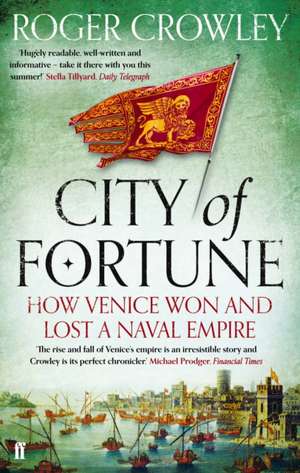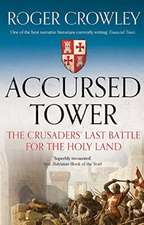City of Fortune
Autor Roger Crowleyen Limba Engleză Paperback – 2 aug 2012
| Toate formatele și edițiile | Preț | Express |
|---|---|---|
| Paperback (2) | 83.16 lei 3-5 săpt. | +13.98 lei 6-12 zile |
| FABER & FABER – 2 aug 2012 | 83.16 lei 3-5 săpt. | +13.98 lei 6-12 zile |
| Random House Trade – 20 mai 2013 | 131.62 lei 3-5 săpt. | +14.37 lei 6-12 zile |
Preț: 83.16 lei
Nou
Puncte Express: 125
Preț estimativ în valută:
15.91€ • 16.65$ • 13.22£
15.91€ • 16.65$ • 13.22£
Carte disponibilă
Livrare economică 13-27 martie
Livrare express 26 februarie-04 martie pentru 23.97 lei
Preluare comenzi: 021 569.72.76
Specificații
ISBN-13: 9780571245956
ISBN-10: 0571245951
Pagini: 448
Ilustrații: Illustrations, maps
Dimensiuni: 128 x 203 x 30 mm
Greutate: 0.34 kg
Ediția:Main
Editura: FABER & FABER
ISBN-10: 0571245951
Pagini: 448
Ilustrații: Illustrations, maps
Dimensiuni: 128 x 203 x 30 mm
Greutate: 0.34 kg
Ediția:Main
Editura: FABER & FABER
Notă biografică
Roger Crowley was born in 1951 and spent part of his childhood in Malta. He read English at Cambridge University and taught English in Istanbul, where he developed a strong interest in the history of Turkey. He has traveled extensively throughout the Mediterranean basin over many years and has a wide-ranging knowledge of its history and culture. He lives in Gloucestershire, England. He is also the author of 1453: The Holy War for Constantinople and The Clash of Islam and the West and Empires of the Sea: The Siege of Malta, the Battle of Lepanto, and the Contest for the Center of the World.
From the Hardcover edition.
From the Hardcover edition.
Extras
Chapter 1
. _1 _.
LORDS OF DALMATIA
1000-1198
The Adriatic Sea is the liquid reflection of Italy, a tapering channel some 480 miles long and 100 wide, pinched tighter at its southern point where it flows into the Ionian past the island of Corfu. At its most northern point, in the enormous curved bay called the Gulf of Venice, the water is a curious blue-green. Here the river Po churns out tons of alluvial material from the distant Alps, which settle to form haunting stretches of lagoon and marsh. So great is the volume of these glacial deposits that the Po Delta is advancing fifteen feet a year and the ancient port of Adria, after which the sea is named, now lies fourteen miles inland.
Geology has made the Adriatic's two coasts quite distinct. The western, Italian shore is a curved, low-lying beach, which provides poor harbors but ideal landing spots for would-be invaders. Sail due east and your vessel will snub against limestone. The shores of Dalmatia and Albania are a four-hundred-mile stretch as the crow flies, but so deeply crenellated with sheltering coves, indents, offshore islands, reefs, and shoals that they comprise two thousand miles of intricate coast. Here are the sea's natural anchorages, which may shelter a whole fleet or conceal an ambush. Behind these features, sometimes stepped back by coastal plain, sometimes hard down on the sea, stand the abrupt white limestone mountains that barricade the sea from the upland Balkans. The Adriatic is the frontier between two worlds.
For thousands of years-from the early Bronze Age until well after the Portuguese rounded Africa-this fault line was a marine highway linking central Europe with the eastern Mediterranean, and a portal for world trade. Ships passed up and down the sheltering Dalmatian shore with the goods of Arabia, Germany, Italy, the Black Sea, India, and the farthest East. Over the centuries they carried Baltic amber to the burial chamber of Tutankhamen; blue faience beads from Mycenae to Stonehenge; Cornish tin to the smelters of the Levant; the spices of Malacca to the courts of France; Cotswold wool to the merchants of Cairo. Timber, slaves, cotton, copper, weapons, seeds, stories, inventions, and ideas sailed up and down these coasts. "It is astonishing," wrote a thirteenth-century Arab traveler about the cities of the Rhine, "that although this place is in the Far West, there are spices there which are to be found only in the Far East- pepper, ginger, cloves, spikenard, costus, and galanga, all in enormous quantities." They came up the Adriatic. This was the point where hundreds of arterial routes converged. From Britain and the North Sea, down the river Rhine, along beaten tracks through the Teutonic forests, across Alpine passes, mule trains threaded their way to the top of the gulf, where the merchandise of the East also landed. Here goods were transshipped and ports flourished; first Greek Adria, then Roman Aquileia, and finally Venice. In the Adriatic, site is everything: Adria silted up; Aquileia, on the coastal plain, was flattened by Attila the Hun in 452; Venice prospered in the aftermath because it was unreachable. Its smattering of low-lying muddy islets set in a malarial lagoon was separated from the mainland by a few precious miles of shallow water. This unpromising place would become the entrepôt and interpreter of worlds; the Adriatic, its passport.
._._.
From the start the Venetians were different. The first, rather idyllic snapshot we have of them, from the Byzantine legate Cassiodorus in 523, suggests a unique way of life, independent and democratic:
You possess many vessels . . . [and] . . . you live like seabirds, with your homes dispersed . . . across the surface of the water. The solidity of the earth on which they rest is secured only by osier and wattle; yet you do not hesitate to oppose so frail a bulwark to the wildness of the sea. Your people have one great wealth-the fish, which suffices for them all. Among you there is no difference between rich and poor; your food is the same, your houses are alike. Envy, which rules the rest of the world, is unknown to you. All your energies are spent on your salt fields; in them indeed lies your prosperity, and your power to purchase those things which you have not. For though there may be men who have little need of gold, yet none live who desire not salt.
The Venetians were already carriers and suppliers of other men's needs. Theirs was a city grown hydroponically, conjured out of marsh, existing perilously on oak palings sunk in mud. It was fragile to the sea's whim, impermanent. Beyond the mullet and eels of the lagoon, and its salt pans, it produced nothing-no wheat, no timber, little meat. It was terribly vulnerable to famine; its sole skills were navigation and the carrying of goods. The quality of its ships was critical.
Before Venice became the wonder of the world, it was a curiosity; its social structure, enigmatic; and its strategies, distrusted. Without land, there could be no feudal system, no clear division between knight and serf. Without agriculture, money was its barter. Its nobles would be merchant princes who could command a fleet and calculate profit to the nearest grosso. The difficulties of life bound all its people together in an act of patriotic solidarity that required self-discipline and a measure of equality-like the crew of a ship all subject to the perils of the deep.
Geographical position, livelihood, political institutions, and religious affiliations marked Venice out. It lived between two worlds: the land and the sea, the East and the West, yet belonging to neither. It grew up a subject of the Greek-speaking emperors in Constantinople and drew its art, its ceremonials, and its trade from the Byzantine world. Yet the Venetians were also Latin Catholics, nominal subjects to the pope, Byzantium's anti-Christ. Between such opposing forces they struggled to maintain a particular freedom. The Venetians repeatedly defied the pope, who responded by excommunicating the whole city. They resisted tyrannous solutions to government and constructed for themselves a republic, led by a doge, whom they shackled with so many restraints that he could receive no gift from foreigners more substantial than a pot of herbs. They were intolerant of overambitious nobles and defeated admirals, whom they exiled or executed, and devised a voting system to check corruption as labyrinthine as the shifting channels of their lagoon.
The tenor of their relations with the wider world was set early. The city wished to trade wherever profit was to be made without fear or favor. This was their rationale and their creed and they pleaded it as a special case. It earned them widespread distrust. "They said many things to excuse themselves . . . which I do not recollect," spat a fourteenth-century churchman after watching the Republic wriggle free of yet another treaty (though he could undoubtedly remember the details painfully well), "excepting that they are a quintessence and will belong neither to the Church nor to the emperor, nor to the sea nor to the land." The Venetians were in trouble with both Byzantine emperors and popes as early as the ninth century for selling war materials to Muslim Egypt, and while purportedly complying with a ban on trade with Islamic countries around 828, they managed to spirit away the body of Saint Mark from Alexandria under the noses of Muslim customs officials, hidden in a barrel of pork. Their standard excuse was commercial necessity: "because we cannot live otherwise and know not how except by trade." Alone in all the world, Venice was organized for economic ends.
By the tenth century they were selling Oriental goods of extraordinary rarity at the important fairs at Pavia on the river Po: Russian ermine, purple cloth from Syria, silk from Constantinople. One monkish chronicler had seen the emperor Charlemagne looking drab beside his retinue in Oriental cloth bought in Pavia from Venetian merchants. (Particularly singled out for clerical tut-tutting was a multicolored fabric interwoven with the figures of birds-evidently an item of outrageous foreign luxury.) To the Muslims Venice traded back timber and slaves-literally Slavs until that people became Christian. Venice was by now well placed at the head of the Adriatic to become the pivot of trade, and on the round turning of the millennium, Ascension Day in the year 1000, Doge Pietro Orseolo II, a man who "excelled almost all the ancient doges in knowledge of mankind," set sail on an expedition that would launch the Republic's ascent to wealth, power, and maritime glory.
On the threshold of the new era, the city stood finely poised between danger and opportunity. Venice was not yet the compact mirage of dazzling stone that it would later become, though its population was already substantial. No splendid palazzi flanked the great S bend of the Grand Canal. The city of wonder, flamboyance, and sin, of carnival masks and public spectacle lay centuries ahead. Instead, low wooden houses, wharves, and warehouses fronted the water. Venice comprised less a unity than a succession of separate islets with patches of undrained marsh and open spaces among the parish settlements, where people grew vegetables, kept pigs and cows, and tended vines. The Church of Saint Mark, a plain predecessor of the extraordinary basilica, had recently been badly burned and patched up after political turmoil that had left a doge dead in its porch; the square in front of it was beaten earth, divided by a canal and partially given over to an orchard. Seagoing vessels that had sailed to Syria and Egypt crowded the commercial heart of the city, the Rivo Alto-contracted over time into the Rialto. Everywhere masts and spars protruded above the buildings.
It was the genius of Orseolo to fully understand that Venice's growth, perhaps its very survival, lay far beyond the waters of the lagoon. He had already obtained favorable trading agreements with Constantinople, and, to the disgust of militant Christendom, he dispatched ambassadors to the four corners of the Mediterranean to strike similar agreements with the Islamic world. The future for Venice lay in Alexandria, Syria, Constantinople, and the Barbary Coast of North Africa, where wealthier, more advanced societies promised spices, silk, cotton, and glass-luxurious commodities that the city was ideally placed to sell on into northern Italy and central Europe. The problem for Venetian sailors was that the voyage down the Adriatic was terribly unsafe. The city's home waters, the Gulf of Venice, lay within its power, but the central Adriatic was risky to navigate, as it was patrolled by Croat pirates. Since the eighth century these Slav settlers from the upper Balkans had established themselves on its eastern, Dalmatian shores. This was a terrain made for maritime robbery. From island lairs and coastal creeks, the shallow-draft Croat ships could dart out and snatch merchant traffic passing down the strait.
Venice had been conducting a running fight with these pirates for 150 years. The contest had yielded little but defeat and humiliation. One doge had been killed leading a punitive expedition; thereafter the Venetians had opted to pay craven tribute for free passage to the open seas. The Croats were now seeking to extend their influence to the old Roman towns farther up the coast. Orseolo brought to this problem a clear strategic vision that would form the cornerstone of Venetian policy for all the centuries that the Republic lived. The Adriatic must provide free passage for Venetian ships, otherwise they would be forever bottled up. The doge ordered that there would be no more tribute and prepared a substantial fleet to command obedience.
Orseolo's departure was accompanied by one of those prescient ceremonies that became a defining marker of Venetian history. A large crowd assembled for a ritual mass at the Church of Saint Peter of Castello, near the site of the present arsenal. The bishop presented the doge with a triumphal banner, which perhaps depicted for the first time Saint Mark's lion, gold and rampant on a red background, crowned and winged, ready for war even as the open gospel between his paws declares peace. The doge and his force then stepped aboard, and with the west wind billowing in their sails, surged out of the lagoon into the boisterous Adriatic. Stopping only to receive further blessing from the bishop of Grado they set sail for the peninsula of Istria on the eastern tip of the Adriatic.
Orseolo's campaign could almost serve as the template for subsequent Venetian policy: a mixture of shrewd diplomacy and the precise application of force. As the fleet worked its way down the small coastal cities-from Parenzo to Pola, Ossero to Zara-the citizens and bishops came out to demonstrate their loyalty to the doge and to bless him with their relics. Those who wavered, weighing Venice against the counterthreat of the Slavs, were more readily convinced by the visible show of force. The Croats saw what was coming and tried to buy the doge off. Orseolo was not to be turned, though his task was made harder by the coastal terrain. The pirates' stronghold was well protected, hidden up the marshy delta of the Narenta River and beyond the reach of any strike force. It was shielded by the three barrier islands of Lesina, Curzola, and Lagosta, whose rocky fortresses presented a tough obstacle.
Relying on local intelligence, the Venetians ambushed a shipload of Narentine nobles returning from trade on the Italian shore and used them to force submission from the Croats at the mouth of the delta. The latter swore to forgo the annual tribute and harassment of the Republic's ships. Only the offshore islands held out. The Venetians isolated them one by one and dropped anchor in their harbors. Curzola was stormed. Lagosta, "by whose violence the Venetians who sailed through the seas were very often robbed of their goods and sent naked away," offered more stubborn resistance. The inhabitants believed their rocky citadel to be impregnable. The Venetians unleashed a furious assault on it from below; when that failed, a detachment made their way up by a steep path behind the citadel and captured the towers that contained the fort's water supply. The defense collapsed. The people were led away in chains and their pirates' nest was demolished.
With this force de frappe, Orseolo put down a clear marker of Venetian intentions, and in case any of the subject cities had forgotten their recent vows, he retraced his footsteps, calling at their startled ports in a repeat show of strength, parading hostages and captured banners. "Thence, passing again by the aforesaid town, making his way back to Venice, he at length returned with great triumph." Henceforward, the doge and his successors awarded themselves a new honorific title-Dux Dalmatiae-"Lord of Dalmatia."
. _1 _.
LORDS OF DALMATIA
1000-1198
The Adriatic Sea is the liquid reflection of Italy, a tapering channel some 480 miles long and 100 wide, pinched tighter at its southern point where it flows into the Ionian past the island of Corfu. At its most northern point, in the enormous curved bay called the Gulf of Venice, the water is a curious blue-green. Here the river Po churns out tons of alluvial material from the distant Alps, which settle to form haunting stretches of lagoon and marsh. So great is the volume of these glacial deposits that the Po Delta is advancing fifteen feet a year and the ancient port of Adria, after which the sea is named, now lies fourteen miles inland.
Geology has made the Adriatic's two coasts quite distinct. The western, Italian shore is a curved, low-lying beach, which provides poor harbors but ideal landing spots for would-be invaders. Sail due east and your vessel will snub against limestone. The shores of Dalmatia and Albania are a four-hundred-mile stretch as the crow flies, but so deeply crenellated with sheltering coves, indents, offshore islands, reefs, and shoals that they comprise two thousand miles of intricate coast. Here are the sea's natural anchorages, which may shelter a whole fleet or conceal an ambush. Behind these features, sometimes stepped back by coastal plain, sometimes hard down on the sea, stand the abrupt white limestone mountains that barricade the sea from the upland Balkans. The Adriatic is the frontier between two worlds.
For thousands of years-from the early Bronze Age until well after the Portuguese rounded Africa-this fault line was a marine highway linking central Europe with the eastern Mediterranean, and a portal for world trade. Ships passed up and down the sheltering Dalmatian shore with the goods of Arabia, Germany, Italy, the Black Sea, India, and the farthest East. Over the centuries they carried Baltic amber to the burial chamber of Tutankhamen; blue faience beads from Mycenae to Stonehenge; Cornish tin to the smelters of the Levant; the spices of Malacca to the courts of France; Cotswold wool to the merchants of Cairo. Timber, slaves, cotton, copper, weapons, seeds, stories, inventions, and ideas sailed up and down these coasts. "It is astonishing," wrote a thirteenth-century Arab traveler about the cities of the Rhine, "that although this place is in the Far West, there are spices there which are to be found only in the Far East- pepper, ginger, cloves, spikenard, costus, and galanga, all in enormous quantities." They came up the Adriatic. This was the point where hundreds of arterial routes converged. From Britain and the North Sea, down the river Rhine, along beaten tracks through the Teutonic forests, across Alpine passes, mule trains threaded their way to the top of the gulf, where the merchandise of the East also landed. Here goods were transshipped and ports flourished; first Greek Adria, then Roman Aquileia, and finally Venice. In the Adriatic, site is everything: Adria silted up; Aquileia, on the coastal plain, was flattened by Attila the Hun in 452; Venice prospered in the aftermath because it was unreachable. Its smattering of low-lying muddy islets set in a malarial lagoon was separated from the mainland by a few precious miles of shallow water. This unpromising place would become the entrepôt and interpreter of worlds; the Adriatic, its passport.
._._.
From the start the Venetians were different. The first, rather idyllic snapshot we have of them, from the Byzantine legate Cassiodorus in 523, suggests a unique way of life, independent and democratic:
You possess many vessels . . . [and] . . . you live like seabirds, with your homes dispersed . . . across the surface of the water. The solidity of the earth on which they rest is secured only by osier and wattle; yet you do not hesitate to oppose so frail a bulwark to the wildness of the sea. Your people have one great wealth-the fish, which suffices for them all. Among you there is no difference between rich and poor; your food is the same, your houses are alike. Envy, which rules the rest of the world, is unknown to you. All your energies are spent on your salt fields; in them indeed lies your prosperity, and your power to purchase those things which you have not. For though there may be men who have little need of gold, yet none live who desire not salt.
The Venetians were already carriers and suppliers of other men's needs. Theirs was a city grown hydroponically, conjured out of marsh, existing perilously on oak palings sunk in mud. It was fragile to the sea's whim, impermanent. Beyond the mullet and eels of the lagoon, and its salt pans, it produced nothing-no wheat, no timber, little meat. It was terribly vulnerable to famine; its sole skills were navigation and the carrying of goods. The quality of its ships was critical.
Before Venice became the wonder of the world, it was a curiosity; its social structure, enigmatic; and its strategies, distrusted. Without land, there could be no feudal system, no clear division between knight and serf. Without agriculture, money was its barter. Its nobles would be merchant princes who could command a fleet and calculate profit to the nearest grosso. The difficulties of life bound all its people together in an act of patriotic solidarity that required self-discipline and a measure of equality-like the crew of a ship all subject to the perils of the deep.
Geographical position, livelihood, political institutions, and religious affiliations marked Venice out. It lived between two worlds: the land and the sea, the East and the West, yet belonging to neither. It grew up a subject of the Greek-speaking emperors in Constantinople and drew its art, its ceremonials, and its trade from the Byzantine world. Yet the Venetians were also Latin Catholics, nominal subjects to the pope, Byzantium's anti-Christ. Between such opposing forces they struggled to maintain a particular freedom. The Venetians repeatedly defied the pope, who responded by excommunicating the whole city. They resisted tyrannous solutions to government and constructed for themselves a republic, led by a doge, whom they shackled with so many restraints that he could receive no gift from foreigners more substantial than a pot of herbs. They were intolerant of overambitious nobles and defeated admirals, whom they exiled or executed, and devised a voting system to check corruption as labyrinthine as the shifting channels of their lagoon.
The tenor of their relations with the wider world was set early. The city wished to trade wherever profit was to be made without fear or favor. This was their rationale and their creed and they pleaded it as a special case. It earned them widespread distrust. "They said many things to excuse themselves . . . which I do not recollect," spat a fourteenth-century churchman after watching the Republic wriggle free of yet another treaty (though he could undoubtedly remember the details painfully well), "excepting that they are a quintessence and will belong neither to the Church nor to the emperor, nor to the sea nor to the land." The Venetians were in trouble with both Byzantine emperors and popes as early as the ninth century for selling war materials to Muslim Egypt, and while purportedly complying with a ban on trade with Islamic countries around 828, they managed to spirit away the body of Saint Mark from Alexandria under the noses of Muslim customs officials, hidden in a barrel of pork. Their standard excuse was commercial necessity: "because we cannot live otherwise and know not how except by trade." Alone in all the world, Venice was organized for economic ends.
By the tenth century they were selling Oriental goods of extraordinary rarity at the important fairs at Pavia on the river Po: Russian ermine, purple cloth from Syria, silk from Constantinople. One monkish chronicler had seen the emperor Charlemagne looking drab beside his retinue in Oriental cloth bought in Pavia from Venetian merchants. (Particularly singled out for clerical tut-tutting was a multicolored fabric interwoven with the figures of birds-evidently an item of outrageous foreign luxury.) To the Muslims Venice traded back timber and slaves-literally Slavs until that people became Christian. Venice was by now well placed at the head of the Adriatic to become the pivot of trade, and on the round turning of the millennium, Ascension Day in the year 1000, Doge Pietro Orseolo II, a man who "excelled almost all the ancient doges in knowledge of mankind," set sail on an expedition that would launch the Republic's ascent to wealth, power, and maritime glory.
On the threshold of the new era, the city stood finely poised between danger and opportunity. Venice was not yet the compact mirage of dazzling stone that it would later become, though its population was already substantial. No splendid palazzi flanked the great S bend of the Grand Canal. The city of wonder, flamboyance, and sin, of carnival masks and public spectacle lay centuries ahead. Instead, low wooden houses, wharves, and warehouses fronted the water. Venice comprised less a unity than a succession of separate islets with patches of undrained marsh and open spaces among the parish settlements, where people grew vegetables, kept pigs and cows, and tended vines. The Church of Saint Mark, a plain predecessor of the extraordinary basilica, had recently been badly burned and patched up after political turmoil that had left a doge dead in its porch; the square in front of it was beaten earth, divided by a canal and partially given over to an orchard. Seagoing vessels that had sailed to Syria and Egypt crowded the commercial heart of the city, the Rivo Alto-contracted over time into the Rialto. Everywhere masts and spars protruded above the buildings.
It was the genius of Orseolo to fully understand that Venice's growth, perhaps its very survival, lay far beyond the waters of the lagoon. He had already obtained favorable trading agreements with Constantinople, and, to the disgust of militant Christendom, he dispatched ambassadors to the four corners of the Mediterranean to strike similar agreements with the Islamic world. The future for Venice lay in Alexandria, Syria, Constantinople, and the Barbary Coast of North Africa, where wealthier, more advanced societies promised spices, silk, cotton, and glass-luxurious commodities that the city was ideally placed to sell on into northern Italy and central Europe. The problem for Venetian sailors was that the voyage down the Adriatic was terribly unsafe. The city's home waters, the Gulf of Venice, lay within its power, but the central Adriatic was risky to navigate, as it was patrolled by Croat pirates. Since the eighth century these Slav settlers from the upper Balkans had established themselves on its eastern, Dalmatian shores. This was a terrain made for maritime robbery. From island lairs and coastal creeks, the shallow-draft Croat ships could dart out and snatch merchant traffic passing down the strait.
Venice had been conducting a running fight with these pirates for 150 years. The contest had yielded little but defeat and humiliation. One doge had been killed leading a punitive expedition; thereafter the Venetians had opted to pay craven tribute for free passage to the open seas. The Croats were now seeking to extend their influence to the old Roman towns farther up the coast. Orseolo brought to this problem a clear strategic vision that would form the cornerstone of Venetian policy for all the centuries that the Republic lived. The Adriatic must provide free passage for Venetian ships, otherwise they would be forever bottled up. The doge ordered that there would be no more tribute and prepared a substantial fleet to command obedience.
Orseolo's departure was accompanied by one of those prescient ceremonies that became a defining marker of Venetian history. A large crowd assembled for a ritual mass at the Church of Saint Peter of Castello, near the site of the present arsenal. The bishop presented the doge with a triumphal banner, which perhaps depicted for the first time Saint Mark's lion, gold and rampant on a red background, crowned and winged, ready for war even as the open gospel between his paws declares peace. The doge and his force then stepped aboard, and with the west wind billowing in their sails, surged out of the lagoon into the boisterous Adriatic. Stopping only to receive further blessing from the bishop of Grado they set sail for the peninsula of Istria on the eastern tip of the Adriatic.
Orseolo's campaign could almost serve as the template for subsequent Venetian policy: a mixture of shrewd diplomacy and the precise application of force. As the fleet worked its way down the small coastal cities-from Parenzo to Pola, Ossero to Zara-the citizens and bishops came out to demonstrate their loyalty to the doge and to bless him with their relics. Those who wavered, weighing Venice against the counterthreat of the Slavs, were more readily convinced by the visible show of force. The Croats saw what was coming and tried to buy the doge off. Orseolo was not to be turned, though his task was made harder by the coastal terrain. The pirates' stronghold was well protected, hidden up the marshy delta of the Narenta River and beyond the reach of any strike force. It was shielded by the three barrier islands of Lesina, Curzola, and Lagosta, whose rocky fortresses presented a tough obstacle.
Relying on local intelligence, the Venetians ambushed a shipload of Narentine nobles returning from trade on the Italian shore and used them to force submission from the Croats at the mouth of the delta. The latter swore to forgo the annual tribute and harassment of the Republic's ships. Only the offshore islands held out. The Venetians isolated them one by one and dropped anchor in their harbors. Curzola was stormed. Lagosta, "by whose violence the Venetians who sailed through the seas were very often robbed of their goods and sent naked away," offered more stubborn resistance. The inhabitants believed their rocky citadel to be impregnable. The Venetians unleashed a furious assault on it from below; when that failed, a detachment made their way up by a steep path behind the citadel and captured the towers that contained the fort's water supply. The defense collapsed. The people were led away in chains and their pirates' nest was demolished.
With this force de frappe, Orseolo put down a clear marker of Venetian intentions, and in case any of the subject cities had forgotten their recent vows, he retraced his footsteps, calling at their startled ports in a repeat show of strength, parading hostages and captured banners. "Thence, passing again by the aforesaid town, making his way back to Venice, he at length returned with great triumph." Henceforward, the doge and his successors awarded themselves a new honorific title-Dux Dalmatiae-"Lord of Dalmatia."
Recenzii
“The rise and fall of Venice’s empire is an irresistible story and [Roger] Crowley, with his rousing descriptive gifts and scholarly attention to detail, is its perfect chronicler.”—The Financial Times
“[Crowley] writes with a racy briskness that lifts sea battles and sieges off the page.”—The New York Times
“Crowley chronicles the peak of Venice’s past glory with Wordsworthian sympathy, supplemented by impressive learning and infectious enthusiasm.”—The Wall Street Journal
“A pleasure to read . . . a gripping story.”—Washington Independent Review of Books
“Fascinating . . . [Crowley writes] absorbingly and accessibly for all readers of history.”—Library Journal
“[Crowley] writes with a racy briskness that lifts sea battles and sieges off the page.”—The New York Times
“Crowley chronicles the peak of Venice’s past glory with Wordsworthian sympathy, supplemented by impressive learning and infectious enthusiasm.”—The Wall Street Journal
“A pleasure to read . . . a gripping story.”—Washington Independent Review of Books
“Fascinating . . . [Crowley writes] absorbingly and accessibly for all readers of history.”—Library Journal



















